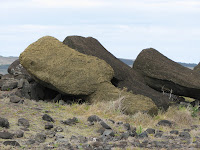

First stop was Ahu Vaihu which is where we viewed numerous toppled moai. They were knocked over by rival tribes during a turbulent time in the island's history. It's rather sad to see these huge monoliths face down or on their side. The pukao of course fell off and some rolled out into the nearby bay. A few definitions: Ahu is a ceremonial platform, Moai is a monolithic statue, Pukao is the hat or topknot (red).



Next we headed to Rano Raraku which is a volcanic crater is where nearly all the moai were carved and nearly 400 remain. Only part of the rock of the volcano hardened and could be used for carving, the rest is too soft. Moai were always carved on their back so that all the details of the face and arms, etc. could be completed at this site. The site is also a national park which charges an admission fee (another US$60) which is good for another park (Rano Kau) as well.
Once the moai were carved here they were taken to other parts of the island and the top hat was added once they were in place. Let me add that the tallest moai ever moved and successfully erected was nearly 30 feet tall and weighed close to 80 tons.



From the side of Rano Raraku one can look off in the distance and see Ahu Tongariki. Here are 15 moai facing inland and the site is impressive. The Ahu is over 700 feet in length! The site was restored between 1992 - 1996. Notice the smile on my face standing in front of these guys!



Next we headed to the north coast to see Anakena which happens to be located next to a beautiful beach with fine white sand (coming from nearby coral that has been pulverized by wave action). We took our lunch break here around 3:00 p.m. and while there were many people swimming, nobody from our group entertained the notion. This is the site where the early Polynesians came and colonized the island. Of note is the detail of the moai, especially the pukao (hats). The site was restored in 1978
From here we headed back to the village and parted company with our beautiful guide Tuhiira.
The weather was partly cloudy and yet there was more than sufficient sun for me to get a mild sunburn. At times the wind was so strong that without a windbreaker there would be lots of goose-bumps. The roads we traveled were a mixture of paved and gravel, more so the latter.